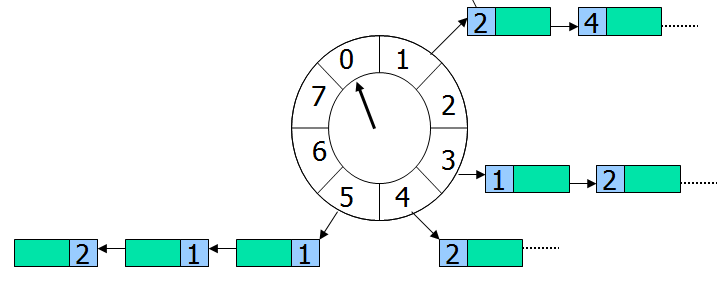标签:
1. 简单介绍.
A Timer optimized for approximated I/O timeout scheduling.
可以看到, HashedWheelTimer 主要用来高效处理大量定时任务, 且任务对时间精度要求相对不高, 比如链接超时管理等场景, 缺点是, 内存占用相对较高.
2. 简单例子.
1) 引入最新的Netty 5依赖 (不一定需要Netty5以前的版本里HashedWheelTimer就已存在)
io.netty
netty-all
5.0.0.Alpha2
2) 例子代码(LocalTime是Java8的时间类)import io.netty.util.HashedWheelTimer;
import java.time.LocalTime;
import java.util.concurrent.TimeUnit;
public class Temp {
public static void main(String[] args) throws Exception {
//创建Timer, 精度为100毫秒,
HashedWheelTimer timer = new HashedWheelTimer(100, TimeUnit.MILLISECONDS, 16);
System.out.println(LocalTime.now());
timer.newTimeout((timeout) -> {
System.out.println(LocalTime.now());
System.out.println(timeout);
}, 5, TimeUnit.SECONDS);
//阻塞main线程
System.in.read();
}
}
可以看到输出:14:55:13.735
14:55:18.845
HashedWheelTimer$HashedWheelTimeout(deadline: 101009856 ns ago, task: com.haogrgr.test.main.Temp$$Lambda$4/708890004@1b797119)
3. 原理简介.
1) 原理如图所示.

可以看到, 就像一个时钟一样, 那么如果写代码来实现一个时钟的话, 大概类似于这样:import java.util.concurrent.Executors;
import java.util.concurrent.ScheduledExecutorService;
import java.util.concurrent.TimeUnit;
import org.apache.commons.lang.math.IntRange;
public class Temp {
public static void main(String[] args) throws Exception {
Clock clock = new Clock().start();
for (int i = 0; i
clock.echo();
Thread.sleep(500);
}
}
}
final class Clock {
static ScheduledExecutorService updater = Executors.newSingleThreadScheduledExecutor();
private int tick = 0;
private int[] wheel = new IntRange(1, 60).toArray();
Clock start() { //1s累加一次tick, 当到60s时归零
updater.scheduleAtFixedRate(() -> tick = ++tick % wheel.length, 0, 1, TimeUnit.SECONDS);
return this;
}
void echo() {
System.out.println("当前时钟 : " + wheel[tick]);
}
}
运行输出:当前时钟 : 1
当前时钟 : 2
当前时钟 : 2
当前时钟 : 3
当前时钟 : 3
回到主题, 来看看HashedWheelTimer的构造函数参数:HashedWheelTimer(
ThreadFactory threadFactory, //类似于Clock中的updater, 负责创建Worker线程.
long tickDuration, //时间刻度之间的时长(默认100ms), 通俗的说, 就是多久tick++一次.
TimeUnit unit, //tickDuration的单位.
int ticksPerWheel //类似于Clock中的wheel的长度(默认512).
):
除了构造函数参数, 还有一个比较重要的概念, 轮(Round) : 一轮的时长为 tickDuration * ticksPerWheel, 也就是转一圈的时长.
其中Worker线程为HashedWheelTimer的核心, 主要负责每过tickDuration时间就累加一次tick. 同时, 也负责执行到期的timeout任务, 同时, 也负责添加timeou任务到指定的wheel中.
当添加Timeout任务的时候, 会根据设置的时间, 来计算出需要等待的时间长度, 根据时间长度, 进而算出要经过多少次tick, 然后根据tick的次数来算出经过多少轮, 最终得出task在wheel中的位置.
例如, 如果任务设置为在100s后执行. 如果按照默认的HashedWheelTimer配置(tickDuration为100ms, wheel长为512)则:任务需要经过的tick数为: (100 * 1000) / 100 = 1000次 (等待时长 / tickDuration)
任务需要经过的轮数为 : 1000次 / 512次/轮 = 1轮 (tick总次数 / ticksPerWheel)
任务存放的wheel索引为 : 1000 - 512 = 488 (走完n轮时间后, 还要多少个tick)
所以这里任务需要经过一轮后, 还要等待488次tick, 才会执行, 进而任务存放的wheel位置也就是488.
到这里, 大概原理已经介绍完了, 接下来看源码吧.
4. 主要成员.
1) HashedWheelTimer, 对外的类, 主要负责启动Worker线程, 添加任务等.
2) Worker, 内部负责添加任务, 累加tick, 执行任务等.
3) HashedWheelTimeout, 任务的包装类, 链表结构, 负责保存deadline, 轮数, 等.
4) HashedWheelBucket, wheel数组元素, 负责存放HashedWheelTimeout链表.
5. HashedWheelTimer源码走读.
下面是HashedWheelTimer的代码, 去掉了一些非关键代码.public class HashedWheelTimer implements Timer {
private static final AtomicIntegerFieldUpdater WORKER_STATE_UPDATER;
static {
AtomicIntegerFieldUpdater workerStateUpdater = PlatformDependent
.newAtomicIntegerFieldUpdater(HashedWheelTimer.class, "workerState");
if (workerStateUpdater == null) {
workerStateUpdater = AtomicIntegerFieldUpdater.newUpdater(HashedWheelTimer.class, "workerState");
}
WORKER_STATE_UPDATER = workerStateUpdater;
}
private final Worker worker = new Worker();
private final Thread workerThread;
public static final int WORKER_STATE_INIT = 0;
public static final int WORKER_STATE_STARTED = 1;
public static final int WORKER_STATE_SHUTDOWN = 2;
@SuppressWarnings({ "unused", "FieldMayBeFinal", "RedundantFieldInitialization" })
private volatile int workerState = WORKER_STATE_INIT; // 0 - init, 1 - started, 2 - shut down
private final long tickDuration;
private final HashedWheelBucket[] wheel;
private final int mask;
private final CountDownLatch startTimeInitialized = new CountDownLatch(1);
private final Queue timeouts = PlatformDependent.newMpscQueue();
private final Queue cancelledTimeouts = PlatformDependent.newMpscQueue();
private volatile long startTime;
//创建Timer
public HashedWheelTimer(ThreadFactory threadFactory, long tickDuration, TimeUnit unit, int ticksPerWheel) {
//校验参数, 代码略
//创建wheel数组, 和HashMap的entry数组长度类似, 为2的次方.
wheel = createWheel(ticksPerWheel);
//用于计算任务存放wheel的索引
//因为wheel长度为2的次方, 则, 如果长度为16(10000), mask就为15(1111)
//那么, 通过 n & mask 就可以实现 类似于 n % mask, 而 & 更高效........
mask = wheel.length - 1;
//tickDuration 不能大于 Long.MAX_VALUE / wheel.length, 也就是一轮的时间不能大于Long.MAX_VALUE 纳秒
this.tickDuration = unit.toNanos(tickDuration);
//创建worker线程
workerThread = threadFactory.newThread(worker);
}
//创建wheel数组
private static HashedWheelBucket[] createWheel(int ticksPerWheel) {
//参数校验, 略
//2的次方
ticksPerWheel = 1;
while (ticksPerWheel
ticksPerWheel <<= 1;
}
//初始化
HashedWheelBucket[] wheel = new HashedWheelBucket[ticksPerWheel];
for (int i = 0; i
wheel[i] = new HashedWheelBucket();
}
return wheel;
}
//启动Timer, 不需要显示调用, 调用newTimeout时, 会自动调用该方法
public void start() {
//初始为WORKER_STATE_INIT, cas修改为WORKER_STATE_STARTED, 并启动worker线程
switch (WORKER_STATE_UPDATER.get(this)) {
case WORKER_STATE_INIT:
if (WORKER_STATE_UPDATER.compareAndSet(this, WORKER_STATE_INIT, WORKER_STATE_STARTED)) {
workerThread.start();
}
break;
case WORKER_STATE_STARTED:
break;
case WORKER_STATE_SHUTDOWN:
throw new IllegalStateException("cannot be started once stopped");
default:
throw new Error("Invalid WorkerState");
}
//等待worker启动, 并初始化startTime完成
while (startTime == 0) {
try {
startTimeInitialized.await();
} catch (InterruptedException ignore) {
// Ignore - it will be ready very soon.
}
}
}
//停止Timer
public Set stop() {
//worker线程不能调用stop方法, 也就是我们添加的Task中不能调用stop方法.
if (Thread.currentThread() == workerThread) {
throw new IllegalStateException(HashedWheelTimer.class.getSimpleName() + ".stop() cannot be called from "
+ TimerTask.class.getSimpleName());
}
//cas修改状态为shutdown, 如果修改失败, 则当前状态只可能是WORKER_STATE_INIT和WORKER_STATE_SHUTDOWN
if (!WORKER_STATE_UPDATER.compareAndSet(this, WORKER_STATE_STARTED, WORKER_STATE_SHUTDOWN)) {
WORKER_STATE_UPDATER.set(this, WORKER_STATE_SHUTDOWN);//总是设置为WORKER_STATE_SHUTDOWN
return Collections.emptySet();//状态为0和2时, 是没有遗留任务的.
}
//中断worker线程, worker线程中会轮询Timer状态的.
boolean interrupted = false;
while (workerThread.isAlive()) {
workerThread.interrupt();
try {
workerThread.join(100);
} catch (InterruptedException ignored) {
interrupted = true;
}
}
//恢复中断标志
if (interrupted) {
Thread.currentThread().interrupt();
}
//返回未处理的任务
return worker.unprocessedTimeouts();
}
//添加定时任务, delay为延迟时间
public Timeout newTimeout(TimerTask task, long delay, TimeUnit unit) {
start();//未启动, 则启动
//任务先添加到timeouts队列中, 等待下一个tick时, 再添加到对应的wheel中去.
long deadline = System.nanoTime() + unit.toNanos(delay) - startTime;
HashedWheelTimeout timeout = new HashedWheelTimeout(this, task, deadline);
timeouts.add(timeout);
return timeout;
}
}
注释的比较详细了, 代码也比较简单, 就不多说了, 看注释吧.
添加任务时, 并不是直接将人物添加到wheel中, 而是先放入队列, 再等待Worker线程在下一次tick时, 将人物放入wheel中.
AtomicIntegerFieldUpdater是JUC的类, Netty会判断, 当存在Unsafe时, 会使用Netty自己利用Unsafe实现的UnsafeAtomicIntegerFieldUpdater.
字数限制... 接第二篇...
标签:




















 308
308











 被折叠的 条评论
为什么被折叠?
被折叠的 条评论
为什么被折叠?








